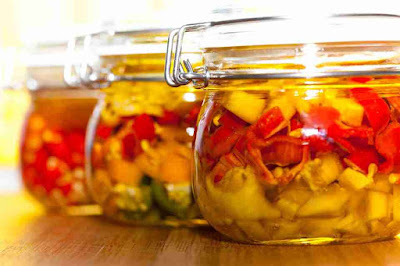With freezers and refrigerators, easy access to
ready-to-use foods, we have forgotten the preservation techniques of our
grandparents: jars, lacto-fermentation, jams, salted, etc. At a time when
packaged foods are singled out because of both ultra-processing and unhealthy
additives and their ecological impact, it is useful to relearn old techniques
that have proven themselves. We are going to talk here about the use of oil to
conserve: which oil? To keep what foods? How to do?
Advantages
The oil prevents mould from growing in food by surrounding
them with a protective film. It is also a natural antioxidant that stops the
oxidation of food, especially by preventing the contact of air with food. Once
completely immersed in the oil, vegetables and other foods are kept for several
years.
In addition, adding aromatics to the oil can pleasantly perfume certain foods.
Today, the best-known canned oil preserves are grilled red peppers and diced ewe's cheese.
The Inconvenient
The food is soaked with oil and it is not possible to
remove all the oil before consumption. If you eat a lot of foods stored in the
oil this can lead to a significant intake of fat.
The olive oil that is most recommended for this method of conservation is not cheap, so it can quickly be expensive unless you live around the Mediterranean.
How to make your
canned oil
Which oil to use?
It is recommended to use olive oil because it is both
good for health and an excellent natural preservative thanks to its antioxidants.
We can also choose rapeseed oil, cheaper. Except that it must then take refined
oil (the organic tastes too pronounced) that contains no protective nutrients
but potentially contains potentially unwanted chemical molecules.
How to proceed?
Wash and rinse the vegetables, cut into pieces and cook
briefly with steam.
Dry the tomatoes in advance in the oven. Lightly brown the eggplants or peppers under the oven grill and peel them. They do not need to be steamed.
For seafood or small fish, it is better to return for a few minutes in oil not too hot.
Arrange the vegetables (or seafood, or small fish) in clean, dry jars with spices and herbs and pour enough oil - heated to about 75 ° C - to cover them completely.
Make sure that no part of the food remains in the open
air.
Press firmly with a spoon on the contents so that all air bubbles rise and the jars can be closed tightly.
It should ideally wait a month before consuming its canned oil. Once opened, however, they must be quickly eaten.
Tips
- Do not hesitate to vary the herbs and spices. For example, peppercorns, thyme and lemon zest make wonder with mushrooms. Tomatoes are sublimated by basil, mint, rosemary or chilli. Eggplant goes well with garlic and lemon.
- The oil in the jars can be used to season dishes after opening.
Precautions
- Choose fresh foods and wash them well.
- Always whiten foods before putting them in oil.
- Always canned foods already cooked (to avoid any bacterial risk).
- Cooking with impeccable hygiene: clean hands and clothes, clean jars (sterilized 15 minutes in boiling water) and dry.
- For seafood, cook them with a little vinegar to kill all the bacteria.
- If the lid offers no resistance to opening, discard the contents of the jar.



0 Comments